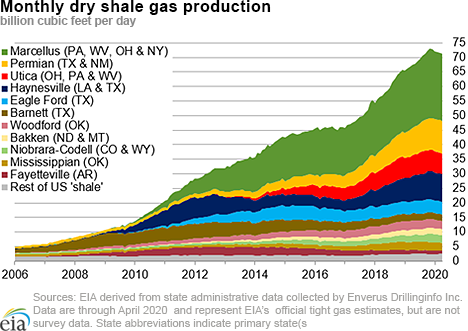In the News:
EIA forecasts record natural gas storage levels
In the June Short-Term Energy Outlook (STEO), EIA forecasts that total working natural gas in underground storage in the Lower 48 states will reach a record level of 4,089 billion cubic feet (Bcf) by October 31, 2020. This forecast storage level would fill the Lower 48 states’ natural gas storage facilities to 87% of their design capacity of 4,693 Bcf and nearly 96% of their demonstrated peak capacity of 4,261 Bcf.
Following a relatively warm heating season (November 1–March 31), with the smallest total net withdrawals since 2015–16, the Lower 48 states’ working natural gas levels on March 31, 2020, were 19% higher than the five-year (2015–19) average and almost 74% higher than the working natural gas levels as of March 31, 2019. EIA estimates that total natural gas injections in the Lower 48 states from April 1 through the end of October this year will be about 2,080 Bcf, or 1% higher than the five-year average. Despite this near-average injection season, the high starting inventory levels lead to a record storage level by the end of October.
The June STEO forecasts that dry natural gas production in the 2020 injection season (April 1–October 31) will average about 88.9 Bcf/d, a decline of about 4% from the same time last year. Although a decrease from its November 2019 record high of 96.2 billion cubic feet per day (Bcf/d), total U.S. dry natural gas production has remained high by historical standards, resulting in high injection levels of natural gas into storage until recently. The expected decline in natural gas production will slow injection activity during the remainder of the refill season. This decline in natural gas production is primarily a result of low expected prices. EIA forecasts the benchmark Henry Hub price to remain lower than $2.00 per million British thermal units (MMBtu) through August 2020 and rise to $2.25/MMBtu in October 2020.
Overall, total consumption plus net exports of natural gas are expected to remain almost unchanged between the 2019 and 2020 injection seasons. The economic decline resulting from the response to the 2019 novel coronavirus disease (COVID-19) is expected to decrease industrial natural gas consumption in the 2020 injection season to about 19.1 Bcf/d, a decrease of almost 12% from 2019 levels; however, this decline is mostly offset by expected consumption increases in other sectors.
Overview:
(For the week ending Wednesday, June 10, 2020)
- Natural gas spot prices fell at most locations this report week (Wednesday, June 3 to Wednesday, June 10). The Henry Hub spot price fell from $1.77 per million British thermal units (MMBtu) last Wednesday to $1.70/MMBtu yesterday.
- At the New York Mercantile Exchange (Nymex), the price of the July 2020 contract decreased 4¢, from $1.821/MMBtu last Wednesday to $1.780/MMBtu yesterday. The price of the 12-month strip averaging July 2020 through June 2021 futures contracts declined 11¢/MMBtu to $2.332/MMBtu.
- The net injections to working gas totaled 93 billion cubic feet (Bcf) for the week ending June 5. Working natural gas stocks totaled 2,807 Bcf, which is 36% more than the year-ago level and 18% more than the five-year (2015–19) average for this week.
- The natural gas plant liquids composite price at Mont Belvieu, Texas, rose by 13¢/MMBtu, averaging $4.60/MMBtu for the week ending June 10. The prices of ethane and natural gasoline fell by 4% and 7%, respectively. The prices of propane, butane, and isobutane rose by 8%, 9%, and 11%, respectively.
- According to Baker Hughes, for the week ending Tuesday, June 2, the natural gas rig count decreased by 1 to 76. The number of oil-directed rigs fell by 16 to 206. The total rig count decreased by 17, and it now stands at the lowest point on record at 284.
Prices/Supply/Demand:
Prices decline despite shut-ins from Tropical Storm Cristobal. This report week (Wednesday, June 3 to Wednesday, June 10), the Henry Hub spot price fell 7¢ from a high of $1.77/MMBtu last Wednesday to $1.70/MMBtu yesterday. Temperatures across the Lower 48 states were mixed: cooler than normal west of the Rocky Mountains and warmer than normal to the east, especially in the Midwest. Beginning late last week, oil and natural gas drilling activities in the U.S. Gulf of Mexico were disrupted by Tropical Storm Cristobal. As of yesterday, natural gas production was still down by 0.9 Bcf/d, according to Genscape. Liquefied natural gas (LNG) feed gas volumes fell 13.4% from last week according to IHS Markit, putting downward pressure on prices. At the Chicago Citygate, the price decreased 17¢ from a high of $1.78/MMBtu last Wednesday to $1.61/MMBtu yesterday.
Northeast prices are down with mild temperatures. At the Algonquin Citygate, which serves Boston-area consumers, the price went down 6¢ from a high of $1.71/MMBtu last Wednesday to $1.65/MMBtu yesterday. At the Transcontinental Pipeline Zone 6 trading point for New York City, the price decreased 1¢ from a high of $1.59/MMBtu last Wednesday to $1.58/MMBtu yesterday.
The Tennessee Zone 4 Marcellus spot price increased 2¢ from $1.42/MMBtu last Wednesday to $1.44/MMBtu yesterday. The price at Dominion South in southwest Pennsylvania remained steady at $1.47/MMBtu.
California prices fall despite declarations of force majeure in the Southwest desert limiting capacity into Southern California. The price at PG&E Citygate in Northern California fell 11¢, down from a high of $2.66/MMBtu last Wednesday to $2.55/MMBtu yesterday. The price at SoCal Citygate in Southern California decreased 31¢ from a high of $2.54/MMBtu last Wednesday to $2.23/MMBtu yesterday. Over the weekend, Southern California experienced mild temperatures. In recent days, however, warmer-than-average weather has moved into the region, with temperatures in Los Angeles reaching nearly 100 degrees Fahrenheit on Tuesday. On June 9, three pipeline companies declared force majeure on lines that serve Southern California because of mechanical failures at compressor stations: El Paso Natural Gas Pipeline, Transwestern, and Kern River. Transwestern and Kern River are expected to return to service on June 13 and 19, respectively. El Paso Natural Gas Pipeline has not issued an anticipated end-date.
Permian Basin differential to the Henry Hub widens. The price at the Waha Hub in West Texas, which is located near Permian Basin production activities, averaged a high of $1.61/MMBtu last Wednesday, 16¢/MMBtu lower than the Henry Hub price. Yesterday, the price at the Waha Hub averaged $1.40/MMBtu, 30¢/MMBtu lower than the Henry Hub price.
Supply falls slightly, driven by lower imports from Canada. According to data from IHS Markit, the average total supply of natural gas fell by 0.2% compared with the previous report week. Average net imports from Canada decreased by 7.5% from last week. According to data from Genscape, imports into the western United States, particularly at Sumas, Washington, and Eastport, Idaho, account for the largest declines. Dry natural gas production grew by 0.3% compared with the previous report week.
Demand rises, driven by the power generation sector. Total U.S. consumption of natural gas rose by 3.1% compared with the previous report week, according to data from IHS Markit. Natural gas consumed for power generation climbed by 8.7% week over week. Natural gas exports to Mexico increased 8.2% as Mexico’s economy began resuming activing following COVID-19-related shutdowns. Conversely, in the residential and commercial sectors, consumption declined by 6.4%. Industrial sector consumption decreased by 1.2% week over week.
U.S. LNG exports decrease week over week. Five liquefied natural gas (LNG) vessels (two from each Sabine Pass and Cameron and one from Cove Point) with a combined LNG-carrying capacity of 18 Bcf departed the United States between June 4 – June 10, 2020, according to shipping data provided by Marine Traffic. This weekly export volume is the lowest since the week of June 8 – June 14, 2017.
Storage:
The net injections into storage totaled 93 Bcf for the week ending June 5, compared with the five-year (2015–19) average net injections of 94 Bcf and last year's net injections of 107 Bcf during the same week. Working natural gas stocks totaled 2,807 Bcf, which is 421 Bcf more than the five-year average and 748 Bcf more than last year at this time.
According to The Desk survey of natural gas analysts, estimates of the weekly net change to working natural gas stocks ranged from net injections of 84 Bcf to 99 Bcf, with a median estimate of 93 Bcf.
The average rate of injections into storage is 16% higher than the five-year average so far in the refill season (April through October). If the rate of injections into storage matched the five-year average of 9. Bcf/d for the remainder of the refill season, the total inventory would be 4,144 Bcf on October 31, which is 421 Bcf higher than the five-year average of 3,723 Bcf for that time of year.
More storage data and analysis can be found on the Natural Gas Storage Dashboard and the Weekly Natural Gas Storage Report.
See also:
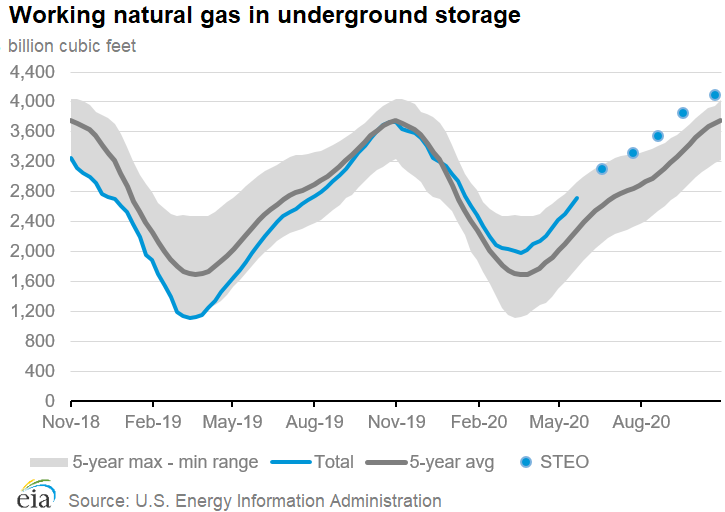
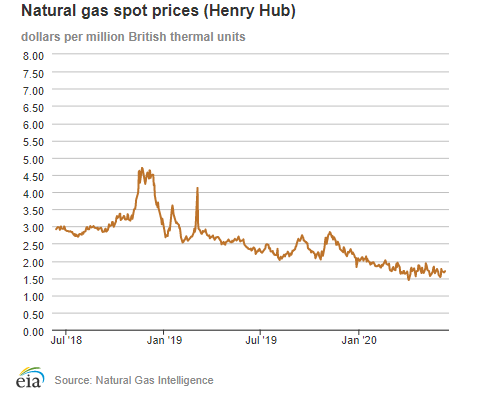
| Spot Prices ($/MMBtu) | Thu, 04-Jun |
Fri, 05-Jun |
Mon, 08-Jun |
Tue, 09-Jun |
Wed, 10-Jun |
|---|---|---|---|---|---|
| Henry Hub |
1.70 |
1.70 |
1.67 |
1.68 |
1.70 |
| New York |
1.45 |
1.34 |
1.55 |
1.57 |
1.58 |
| Chicago |
1.71 |
1.59 |
1.63 |
1.63 |
1.61 |
| Cal. Comp. Avg.* |
1.99 |
1.88 |
1.88 |
1.92 |
1.95 |
| Futures ($/MMBtu) | |||||
| July contract | 1.822 |
1.782 |
1.789 |
1.767 |
1.780 |
| August contract |
1.917 |
1.886 |
1.892 |
1.863 |
1.870 |
| *Avg. of NGI's reported prices for: Malin, PG&E Citygate, and Southern California Border Avg. | |||||
| Source: NGI's Daily Gas Price Index | |||||
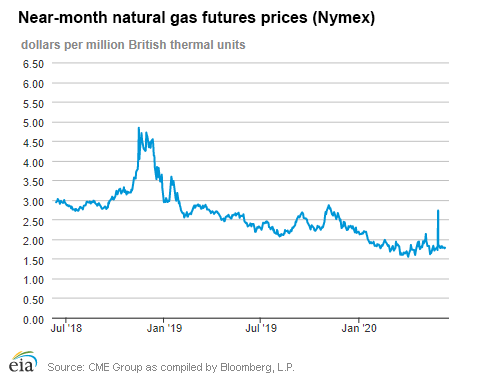
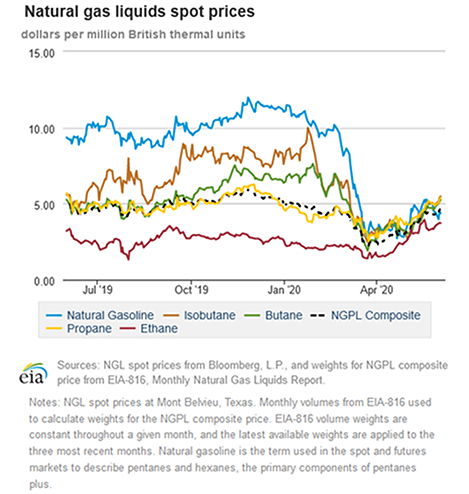
| U.S. natural gas supply - Gas Week: (6/4/20 - 6/10/20) | |||
|---|---|---|---|
Average daily values (Bcf/d): |
|||
this week |
last week |
last year |
|
| Marketed production | 101.0 |
100.7 |
100.7 |
| Dry production | 89.5 |
89.3 |
89.2 |
| Net Canada imports | 4.1 |
4.4 |
4.9 |
| LNG pipeline deliveries | 0.1 |
0.2 |
0.1 |
| Total supply | 93.7 |
93.9 |
94.2 |
|
Source: IHS Markit | |||
| U.S. natural gas consumption - Gas Week: (6/4/20 - 6/10/20) | |||
|---|---|---|---|
Average daily values (Bcf/d): |
|||
this week |
last week |
last year |
|
| U.S. consumption | 64.5 |
62.5 |
63.0 |
| Power | 35.2 |
32.4 |
32.3 |
| Industrial | 20.4 |
20.7 |
21.3 |
| Residential/commercial | 8.9 |
9.5 |
9.3 |
| Mexico exports | 5.4 |
5.0 |
5.1 |
| Pipeline fuel use/losses | 5.4 |
6.1 |
6.2 |
| LNG pipeline receipts | 4.1 |
5.3 |
5.3 |
| Total demand | 79.4 |
78.9 |
79.6 |
|
Source: IHS Markit | |||
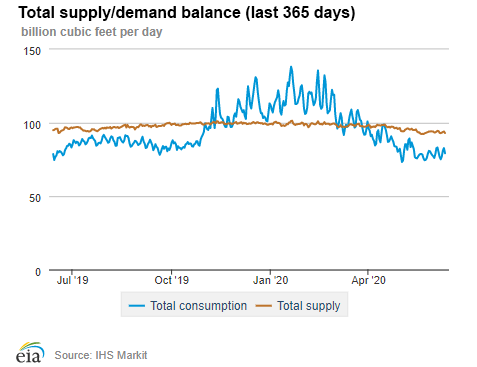
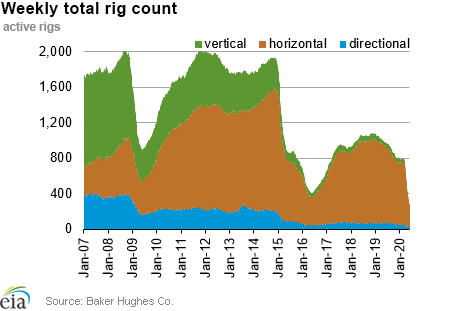
| Rigs | |||
|---|---|---|---|
Tue, June 02, 2020 |
Change from |
||
last week |
last year |
||
| Oil rigs | 206 |
-7.2% |
-73.9% |
| Natural gas rigs | 76 |
-1.3% |
-59.1% |
| Note: Excludes any miscellaneous rigs | |||
| Rig numbers by type | |||
|---|---|---|---|
Tue, June 02, 2020 |
Change from |
||
last week |
last year |
||
| Vertical | 7 |
0.0% |
-84.8% |
| Horizontal | 253 |
-6.6% |
-70.4% |
| Directional | 24 |
4.3% |
-67.6% |
| Source: Baker Hughes Co. | |||
| Working gas in underground storage | ||||
|---|---|---|---|---|
Stocks billion cubic feet (Bcf) |
||||
| Region | 2020-06-05 |
2020-05-29 |
change |
|
| East | 563 |
536 |
27 |
|
| Midwest | 662 |
634 |
28 |
|
| Mountain | 148 |
140 |
8 |
|
| Pacific | 281 |
273 |
8 |
|
| South Central | 1,153 |
1,131 |
22 |
|
| Total | 2,807 |
2,714 |
93 |
|
|
Source: Form EIA-912, Weekly Underground Natural Gas Storage Report | ||||
| Working gas in underground storage | |||||
|---|---|---|---|---|---|
Historical comparisons |
|||||
Year ago (6/5/19) |
5-year average (2015-2019) |
||||
| Region | Stocks (Bcf) |
% change |
Stocks (Bcf) |
% change |
|
| East | 433 |
30.0 |
461 |
22.1 |
|
| Midwest | 460 |
43.9 |
518 |
27.8 |
|
| Mountain | 108 |
37.0 |
146 |
1.4 |
|
| Pacific | 223 |
26.0 |
272 |
3.3 |
|
| South Central | 836 |
37.9 |
988 |
16.7 |
|
| Total | 2,059 |
36.3 |
2,386 |
17.6 |
|
| Source: Form EIA-912, Weekly Underground Natural Gas Storage Report | |||||
| Temperature – heating & cooling degree days (week ending Jun 04) | ||||||||
|---|---|---|---|---|---|---|---|---|
HDD deviation from: |
CDD deviation from: |
|||||||
| Region | HDD Current |
normal |
last year |
CDD Current |
normal |
last year |
||
| New England | 30 |
0 |
-1 |
18 |
13 |
16 |
||
| Middle Atlantic | 19 |
-3 |
2 |
22 |
9 |
10 |
||
| E N Central | 21 |
-7 |
2 |
29 |
7 |
12 |
||
| W N Central | 14 |
-9 |
3 |
42 |
13 |
7 |
||
| South Atlantic | 3 |
-4 |
1 |
72 |
14 |
-11 |
||
| E S Central | 3 |
-4 |
3 |
58 |
7 |
-12 |
||
| W S Central | 0 |
0 |
0 |
85 |
4 |
-12 |
||
| Mountain | 2 |
-34 |
-23 |
68 |
32 |
35 |
||
| Pacific | 9 |
-16 |
3 |
24 |
9 |
13 |
||
| United States | 12 |
-9 |
0 |
46 |
10 |
5 |
||
|
Note: HDD = heating degree day; CDD = cooling degree day Source: National Oceanic and Atmospheric Administration | ||||||||
Average temperature (°F)
7-day mean ending Jun 04, 2020
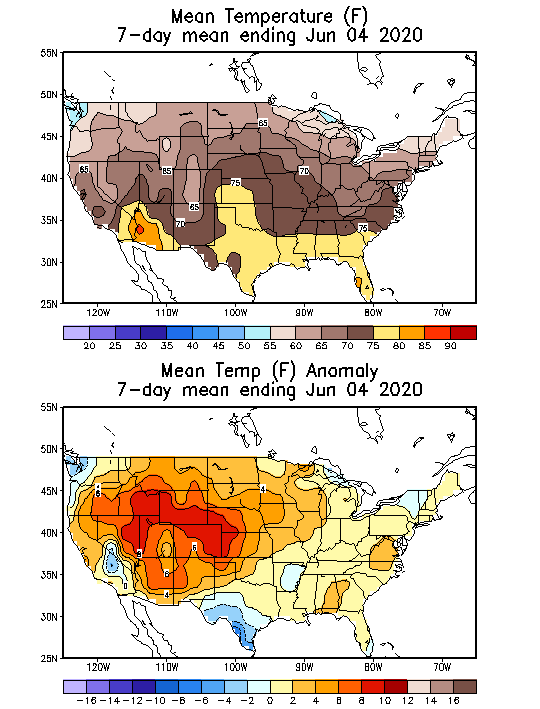
Source: National Oceanic and Atmospheric Administration
Deviation between average and normal (°F)
7-day mean ending Jun 04, 2020

Source: National Oceanic and Atmospheric Administration

